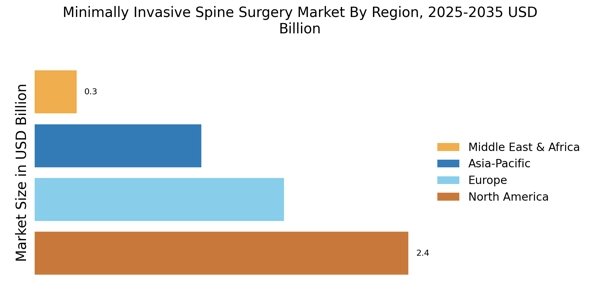Supportive Regulatory Environment
A supportive regulatory environment is essential for the growth of the Minimally Invasive Spine Surgery Market. Regulatory bodies are increasingly recognizing the benefits of minimally invasive techniques, leading to streamlined approval processes for new devices and procedures. This regulatory support fosters innovation and encourages manufacturers to invest in research and development. Recent initiatives aimed at expediting the approval of advanced surgical technologies have the potential to enhance market dynamics significantly. As new products enter the market more rapidly, healthcare providers gain access to cutting-edge solutions that improve patient outcomes. This favorable regulatory landscape is likely to sustain the momentum of growth in the Minimally Invasive Spine Surgery Market.
Rising Prevalence of Spine Disorders
The increasing incidence of spine disorders, such as herniated discs and spinal stenosis, is a primary driver for the Minimally Invasive Spine Surgery Market. As populations age, the prevalence of these conditions tends to rise, leading to a greater demand for effective treatment options. According to recent estimates, approximately 80% of individuals experience back pain at some point in their lives, which underscores the need for innovative surgical solutions. Minimally invasive techniques offer reduced recovery times and lower complication rates, making them attractive options for both patients and healthcare providers. This trend is likely to continue, as more individuals seek surgical interventions to alleviate chronic pain and improve their quality of life.
Enhanced Patient Awareness and Education
The rising awareness among patients regarding treatment options for spine disorders is a significant driver for the Minimally Invasive Spine Surgery Market. As patients become more informed about the benefits of minimally invasive techniques, including reduced pain and faster recovery, they are more likely to seek these options. Educational initiatives by healthcare providers and advocacy groups have contributed to this trend, empowering patients to make informed decisions about their care. Surveys indicate that a substantial percentage of patients express a preference for minimally invasive procedures when informed about their advantages. This heightened awareness is expected to continue influencing patient choices, thereby driving demand in the Minimally Invasive Spine Surgery Market.
Technological Innovations in Surgical Techniques
Technological advancements play a crucial role in shaping the Minimally Invasive Spine Surgery Market. Innovations such as robotic-assisted surgery, advanced imaging techniques, and improved surgical instruments have revolutionized the way spine surgeries are performed. These technologies enhance precision, reduce trauma to surrounding tissues, and facilitate quicker recovery times. For instance, the integration of 3D imaging allows surgeons to visualize the spine in real-time, leading to more accurate procedures. The market for surgical robotics is projected to grow significantly, indicating a strong trend towards adopting these advanced technologies in spine surgery. As these innovations continue to evolve, they are expected to drive further growth in the Minimally Invasive Spine Surgery Market.
Increasing Demand for Outpatient Surgical Procedures
The shift towards outpatient surgical procedures is a notable trend influencing the Minimally Invasive Spine Surgery Market. Patients increasingly prefer surgeries that allow them to return home the same day, minimizing hospital stays and associated costs. This preference is driven by the desire for convenience and the growing emphasis on cost-effective healthcare solutions. Minimally invasive techniques align well with this trend, as they typically require shorter recovery times and less postoperative care. Data suggests that outpatient spine surgeries have seen a rise of over 30% in recent years, reflecting a significant change in patient expectations and healthcare delivery models. This growing demand is likely to propel the Minimally Invasive Spine Surgery Market forward.


















Leave a Comment